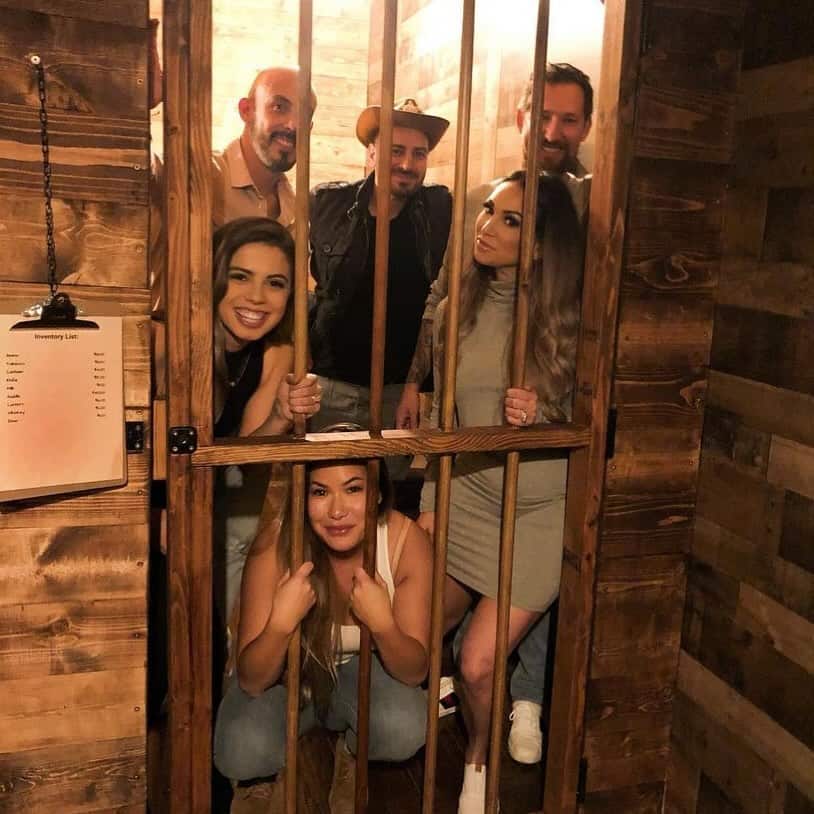Understanding How Do Escape Rooms Work
Imagine being locked in a room that’s a cobweb of mysteries, each clue a golden thread leading you closer to freedom.That’s the heart-racing essence of an escape room adventure, where teamwork is the key, and every corner turned could be a step closer to unlocking the treasure of experience—or the jaws of a horror film scenario snapping shut. Wondering how do escape rooms work? They are a realm where the game master plays puppeteer, strings of tension taut with anticipation, guiding players through a maze of problem-solving trials.
Technological wonders like virtual reality often add a layer of tantalizing illusion, blurring the lines between game and reality, leaving your heart pounding as if you were truly planning a prison break. Keep reading to unlock the secrets of how these experiences are crafted.
Defining the Concept of an Escape Room Experience
Alright, so here’s the scoop on escape rooms, a concept that has been tantalizing thrill-seekers and problem-solving aficionados for a bit now.
They’re these adventure games where you get locked in a room, metaphorically or literally, and the clock starts ticking for your escape. But, it’s not just about finding the key and breaking out of the prison, oh no; it’s a dance of clues, riddles, and teamwork that makes Sherlock out of Average Joes. Now, before we get to the nitty-gritty of how these immersive puzzles went from a “what’s that?” to a “let’s do that!” we’ve got to understand their roots. They didn’t just appear out of thin air. These games have evolved from horror film-like scenarios to virtual reality extravaganzas that’d make any tech junkie’s heart race.
The Roots and Evolution of Escape Rooms
Let’s turn back the clock for a minute, these mind-bending rooms started as computer games that planted the seeds for what would bloom into real-life escape room experiences. Picture this: what used to be a single player sitting in front of a screen is now a full-blown, heart-racing adventure with a crew of friends or even strangers, all eager to crack the code.
Interactive Gameplay: More Than Just a Locked Room
Interactive gameplay in escape rooms is like stepping into a movie where you’re both the director and the lead actor – it’s your choices that shape the story. Every creaky cupboard or dusty bookshelf might be hiding secrets as if the room itself is whispering riddles in your ear. It’s up to your squad to piece together this puzzle, turning an ordinary outing into a collaborative theater where everyone plays a part.
Trust me, calling them just ‘rooms’ is like saying the Grand Canyon is a mere ditch; these spaces are canvases for the imagination. With a gamemaster acting as the puppeteer, pulling strings from behind the curtain, you’re tossed into scenarios that demand more than simple problem solving – they require a symphony of communication, wit, and a dash of luck. Every second is a beat in the rhythm of escape, and each discovery feels like uncovering a long-lost treasure.
The Genesis of an Escape Room: From Idea to Reality
So, I heard you wanna know the nitty-gritty, the real deal behind how do escape rooms work, right? Well, you’ve come to the perfect place, my friend! It’s not just about tossing puzzles into a space and slapping a timer on the wall. The birthing process of an escape room—now that’s where the magic happens. It begins with spinning a tale intriguing enough to make a bard weep; it’s about crafting the narrative, weaving a web of intrigue that beckons players into its fold. And let’s not forget about the bread and butter of these adventures: the puzzles.
Crafting the Narrative: Building an Engaging Story
Now, when it comes to spinning a riveting escape room narrative, think of it as cooking up the most tantalizing tale that could ensnare the senses. You’re not just plopping folks in a room; you’re inviting them into the beating heart of a story, complete with twists and turns, ready to unfurl like a mystery-flavored cinnamon roll. It’s all in the details – the echoes of footsteps in a haunted mansion or the flickering lights of an abandoned spaceship.
Designing Challenges: The Core of Interactive Puzzles
Imagine being the architect of a maze where every twist and turn is a product of your own brainwaves. That’s what it feels like to design the interactive puzzles at the heart of an escape room. The game is to create challenges that stir up a storm in your neurons, making you feel like Einstein and a rookie detective rolled into one.
Types of Puzzles Encountered in Escape Rooms
Ever been knee-deep in an escape room, feeling like your brain is doing gymnastics while your pulse races like you’re running a marathon? That, my friends, is the sweet spot these adventures aim for, mingling physical tasks with mental acrobatics. Let’s go over the spectrum of puzzles you might bump into, shall we? From riddles that could twist your neurons into pretzels to tests of dexterity that remind you of those old-school carnival games, it’s all about that precious balance.
After this, you’ll look at a padlock with newfound respect and puzzle over patterns like you’re deciphering an ancient script. Going in, you should know it’s more than brainteasers; it’s a journey. Now, buckle up, because I’m about to give you a backstage pass to my experiences of knowing how do escape rooms work
Physical vs. Mental Challenges: A Balancing Act
Let me tell you, juggling the brawn with the brain in these escape room capers is like trying to balance on a tightrope while solving a crossword puzzle. You’ve got physical trials that might have you feeling like an archaeologist digging for pharaoh’s treasure, and then there are mental gauntlets that put your powers of logic to the ultimate test.
Picture yourself decrypting an ancient code that unlocks the next clue; that’s your mind firing on all cylinders. But the next moment, you’re racing to arrange artifacts in a pattern, your hands trembling with urgency as the clock ticks down. It’s this rollercoaster of mental and physical challenges that turns an escape room from a simple game into an electrifying experience.
Sequential Puzzles: Leading Players on a Journey
The moment you think you’ve conquered one riddle, bam! You’re met with a sequence that’s like a breadcrumb trail, luring you deeper into the game’s embrace. These sequential puzzles are the heartbeat of the journey, each one a stepping stone that nudges the story forward, threading the narrative beads onto the string of the overarching adventure.
And let me tell ya, nothing compares to that eureka moment when the pieces fall into place, revealing the path ahead like a curtain being lifted on a new act of a play. These puzzles aren’t just a set of random problems; they’re cleverly designed stepping stones that weave together, creating a tapestry of accomplishment with each successful stride we take.
The Psychological Elements at Play in Escape Rooms
So, there I was, crammed into this space with my crew of friends, all of us facing the intense, ticking countdown of the escape room’s clock. The air was thick with intrigue and silent questions, as each of us dove deep into our thoughts, trying to suss out what made each other tick just as much as the puzzles before us. I’ve always been fascinated by the psychological play at hand—how each of us morphed under pressure, and how our decisions shifted gears when that pressure cranked up a notch.
Group Dynamics and Communication in Tight Scenarios
So there we were, all keen minds funneled into a single chamber of whispers and sideways glances, where every gesture is a word and silence speaks volumes. Group dynamics in an escape room unroll like a suspenseful tapestry, where weaved within are threads of leadership, roles swapping fluidly as the puzzle dictates, and I find it’s the understated nod, the collective breath held in anticipation, that solidifies us as a temporary family against the clock.
It’s bonkers, really, how our voices rise and fall, an orchestra minus the conductor, where the crescendo builds not with music, but with the ping-pong of ideas tossed across the room. Communication here is key, and it twists and buckles under pressure, a living thing that can be your lifeline or the noose that tightens with every tick-tock, a reminder that we’re all in this head-scratching enigma together.
Time Pressure and Stress: How They Affect Decision Making
Imagine you’re in an escape room, the clock’s hands racing like frantic drummers setting the beat for your heart’s panicked rhythm. Under the gun, with mere minutes on the board, I feel my mind throw caution to the wind; decisions leap out before being fully formed, reckless but raw, revealing the fascinating ways stress stirs the pot of our problem-solving stew.
The room becomes a pressure cooker where time is the relentless heat; as the timer bleeds away, I sense our strategies morph, rapid-fire and less refined.
Ready to escape the ordinary? Book your Brainy Actz adventure today
Okay, escape room fans! We cracked the code on why these puzzling playgrounds rock: fun, teamwork, and mind-blowing triumphs await! Whether you’re a pro code-cracker or a curious newbie, escaping never gets old.
Craving the best escape room ever? Check out Brainy Actz! They’ve got awesome themes, sneaky puzzles, and a crew that love making your escape dreams come true. It’s like stepping into a super fun maze – except you use your brain to win!
Grab your best buds, put on your thinking caps, and get ready for an epic adventure at Brainy Actz. Remember, you can’t break free without working together – that’s the magic! So ditch the boring stuff and book your Brainy Actz escape today. It’s not just a game, it’s a memory-making adventure!


